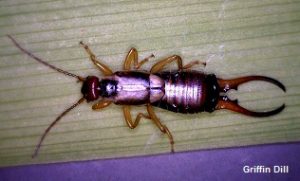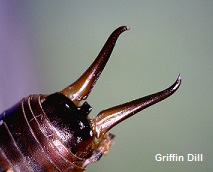Earwigs
Pest Management Fact Sheet #5017
Clay A. Kirby, Insect Diagnostician
James F. Dill, Pest Management Specialist
Griffin M. Dill, IPM Professional
For information about UMaine Extension programs and resources, visit extension.umaine.edu.
Find more of our publications and books at extension.umaine.edu/publications/.
Description & Biology
Earwigs are reddish brown insects that are up to 3/4 inch long when fully grown. They have chewing mouthparts and long, slender antennae. They have a pair of pincer-like cerci (commonly called “pincers”) extending from the back end. The pincers are used for defense and also to catch other insects on which earwigs sometimes feed. Young earwigs resemble adults but are smaller.
- Earwig
- Earwig Pincers
Earwigs are nocturnal, actively feeding during the night and hiding during the day. As morning approaches, they search for a place to hide, preferably a dark, damp area underneath things such as wood piles, boards, rubbish, etc. Or they may hide near plants, rock borders or even inside a home. Generally, they do not actively infest homes, but as they go up the foundations, any open area around the sill, door or window that will allow them to enter becomes an invitation to move in. They are not known to cause any damage to homes or their contents, but they are definitely a nuisance, especially when they turn up in unusual places.
The name earwig comes from a superstition that these insects entered the ears of a sleeping person and bored into the brain. This belief is totally unfounded.
Female earwigs mother their eggs and young until they are big enough to wander away from the nest and obtain their own food. Usually, earwigs are first noticed in the spring around the outside of the home near the foundation. A certain percentage of adults and eggs survive through the winter.
Earwigs feed on flowers, other ornamentals and vegetables. Feeding damage appears as foliar holes and lacework due to their chewing mouthparts. Corn silk is a favorite food which is often consumed as it grows. This prevents pollination and causes poorly developed ears with many kernels missing on the cobs. As populations increase and spread, the areas in which they hide become more unusual. For example, they may be found on a roof under shingles, under siding, or under items hanging on walls as well as the usual hiding places mentioned above. Because earwigs also feed on decomposing organic matter, compost and mulch may provide food and shelter.
Management
Sanitation: Sanitation is most important. Avoid providing earwigs with ideal nesting and hiding places; that is, any place an earwig could hide in, under or between. Removing these hiding places is a continuous job, but the most important time to start is spring when plants are not yet sprouted and most outdoor items can be moved. Any items left outdoors overnight; for example: laundry, lawn furniture, flowers, or vegetables– should be examined for earwigs before they are brought into the home. Earwigs are spread primarily by transportation of products. Thus, items purchased at yard sales should also be examined (e.g. cardboard boxes in damp outside areas). It is possible that most areas around homes are likely to be infested with earwigs. While it is unlikely that they can ever be completely eliminated, you can keep populations at acceptable levels.
Traps: Traps can be made from two pieces of grooved wood placed together; these can be leaned against a tree or the foundation. Also 18-inch lengths of old garden hose (cut at a slant to allow greater exposure of the opening) can be laid in the area where earwigs are present. Place traps in earwig areas at dusk and empty traps the following morning. Placing boards or other items on the ground to serve as a hiding place also makes for an effective trap. A rolled-up, moistened newspaper also functions as a good trap. Shaking the earwigs out of the traps or placing hose sections into a pail with a small amount of hot soapy water ends the pests’ travels.
Chemical Control: Some of the least toxic outdoor options include spinosad or iron phosphate. Other options include bifenthrin, permethrin, resmethrin, and carbaryl which can be applied in a 10-foot band around the home (according to label directions). Include the foundation area, especially by basement doors and windows, where the sill of the house rests on the foundation, and where the siding begins. Sprinkle enough water on the sprayed ground to wash the insecticide off any plants and onto the soil (but not into the soil), where the earwigs will have the greatest exposure to the insecticide.
Indoor chemical control of earwigs is generally not recommended. Earwigs found in the home can be removed with a vacuum cleaner or broom. If earwigs are controlled outside, it is quite unlikely that inside control will prove to be necessary, other than using a fly swatter, rolled newspaper, or vacuum cleaner to kill or clean up strays.
When Using Pesticides
ALWAYS FOLLOW LABEL DIRECTIONS!
Pest Management Unit
Cooperative Extension Diagnostic and Research Laboratory
17 Godfrey Drive, Orono, ME 04473
1.800.287.0279 (in Maine)
Information in this publication is provided purely for educational purposes. No responsibility is assumed for any problems associated with the use of products or services mentioned. No endorsement of products or companies is intended, nor is criticism of unnamed products or companies implied.
© 2016, 2020 | Reviewed: 2023
Call 800.287.0274 (in Maine), or 207.581.3188, for information on publications and program offerings from University of Maine Cooperative Extension, or visit extension.umaine.edu.
In complying with the letter and spirit of applicable laws and pursuing its own goals of diversity, the University of Maine System does not discriminate on the grounds of race, color, religion, sex, sexual orientation, transgender status, gender, gender identity or expression, ethnicity, national origin, citizenship status, familial status, ancestry, age, disability physical or mental, genetic information, or veterans or military status in employment, education, and all other programs and activities. The University provides reasonable accommodations to qualified individuals with disabilities upon request. The following person has been designated to handle inquiries regarding non-discrimination policies: Director of Equal Opportunity, 101 Boudreau Hall, University of Maine, Orono, ME 04469-5754, 207.581.1226, TTY 711 (Maine Relay System).



